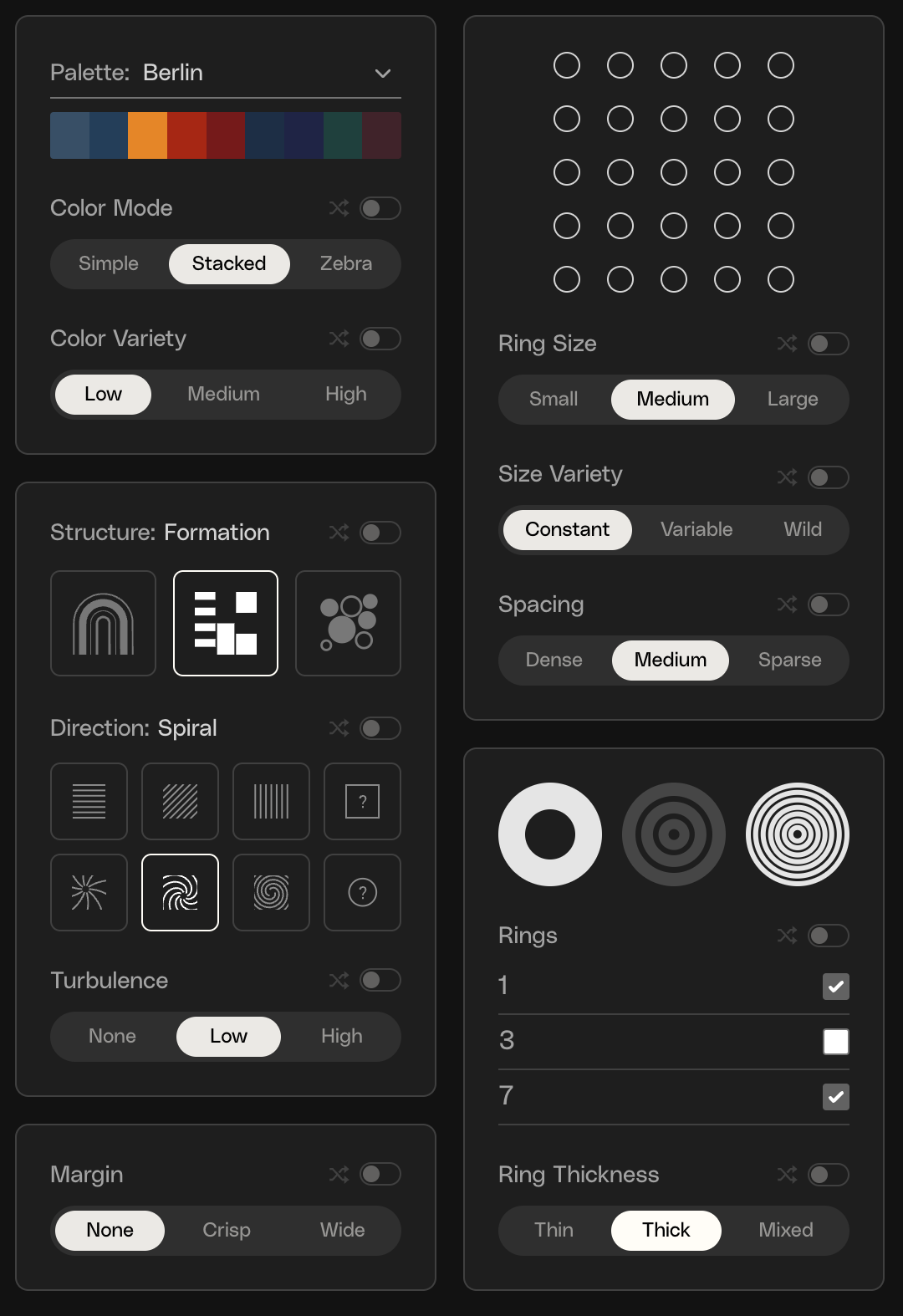Exploring QQL
I.
A basic premise of on-chain generative art is that minters aren't just buying a finished piece: they're also intimately involved in the creation process.
This is good for artists. Art is subjective, and people are more likely to feel emotionally connected to something they've helped to create. It also enables new types of interactions between artists and their audiences.
In many cases, there is a slot machine dynamic involved in the minting process. Minters receive a random output from the algorithm. Although they help create the piece, minters have no control over what is produced.
We're beginning to see new mechanisms challenge this.
Ben Kovach's 100 PRINT was pre-minted and collectors chose outputs from the collection using a draft. The outputs minted by the algorithm were still random, but collectors could select pieces that fit their personal preferences.
I'm excited to see more experimentation in this area. In many cases, the generative algorithms behind these collections take months or years of work. Randomness is one way to appreciate an algorithm, but it's suboptimal for collectors who want to explore specific aspects of the work.
QQL is an attempt to solve this using a generative algorithm and toolkit created by Tyler Hobbs and Dandelion Wist. Unlike a traditional generative drop, the outputs are generated by the collectors before being minted on-chain. You can read more about it here.
II.
QQL is interesting to me for several reasons:
- It expands the output space that collectors are familiar with. Rather than thinking of the algorithm strictly as the minted pieces, the audience is aware of a broader range of potential outputs.
- The ongoing discovery period will surface some clear favorites (e.g. patterns, palettes, etc.). This will build consensus around "good" outputs and gives minters more choice when deciding whether or not to purchase.
- I suspect that the average quality of minted works will be higher. Minters have an incentive to maximize the value of their pieces and can choose to self-select for personal aesthetic preferences or to fill in a "gap" in the minted outputs that are statistically rarer or satisfy an unmet niche.
- Since minting is open indefinitely, it extends the "surprise and delight" period of the drop. Holders can choose to leave their Mint Pass unredeemed in case new outputs are discovered down the road.
The algorithm itself is quite diverse and the website provides a helpful interface to explore the output space. Collectors can manipulate various aspects of the algorithm and see how it affects the resulting output.

For the past few days, the generative art community has been exploring QQL. Searching #QQLContest on Twitter turns up thousands of results, each submitted by a hopeful winner of the QQL Mint Pass giveaway.
Rather than limiting QQL to the 999 outputs minted on-chain, this exploratory process has generated millions of potential outputs. Although the output space is technically finite, this type of mechanism allows collectors to understand just how much complexity a single algorithm can produce.
III.
As part of my own exploration, I identified various archetypes – classes of outputs that share similar characteristics. To improve my intuition, I collected examples of various outputs within each archetype and decomposed their traits to identify structural similarities.
The following examples are not meant to be exhaustive, nor do they represent the opinion of the creators. By organizing and presenting several examples of archetypes, I hope to spark a discussion about the types of representative outputs within the collection and build a shared vocabulary that can be used while discussing combinations of traits.
Wave

Wave outputs tend to rely on the Spiral direction, although Random Radial can also produce visually similar outputs. The Wave works best when the foreground is clearly separated from the background by color or varying ring size.
Dithering

The Dithering archetype is caused when two overlapping layers create the illusion of a third. The resulting effect is a sort of optical illusion – a visual artifact that is best seen from the periphery and resists direct examination.
Landscape

Landscape archetypes evoke a sense of depth through densely spaced rings. Mountains, roads, plains, and sand dunes are commonly depicted in Landscape outputs. There is often a dominant perspective, with the eye being drawn to a focal point in the scene: the end of the road or the horizon.
Mimetic

Memetic outputs resemble physical objects. From left to right in the examples above: a Wine Bottle, a Rooster, and an Arrow. Memetic outputs can be produced by any combination of traits.
The Solo Dot

The Solo Dot emphasizes the distinction of a single ring. Color variety is often low to create a two-toned palette that is simple and distinctive.
Spiral

Spiral outputs heavily utilize a single large spiral as their defining characteristic, often paired with bold colors. The Spiral is a fan favorite due to the similarities to popular Fidenza outputs and is one of the most visually appealing Structures.
IV.
While choosing an output for the competition it was important to me that I select something which matches my own preferences.
My criteria included:
- It should be distinctive. Memorable outputs have a name, and those names are intuitive and widely recognized. It should be as iconic as The Tulip.
- It should be surprising. Those who are familiar with the algorithm should see it and think "how did that output happen?"
- It should be easily recognizable as a thumbnail, but stand up well to closer inspection, especially as a printed work.
In the end, I chose "Blank Canvas" as my submission:

Art should spark conversation. Choosing an almost entirely blank output is an excellent way to do that, especially since it naturally leads to a discussion about the algorithm and curation process.
The piece itself is surprisingly rich in detail.
I used a Seoul palette with low variety and a simple color mode to achieve the background. The rings are constant-sized and placed into a sparse horizontal grid. The symmetrical grid is only visible upon closer inspection and each dot consists of three concentric rings, representing the three curated outputs chosen to demonstrate the algorithm.
To me, Blank Canvas represents everything that is possible with QQL. I had a lot of fun making it; I hope you enjoy it as much as I do.